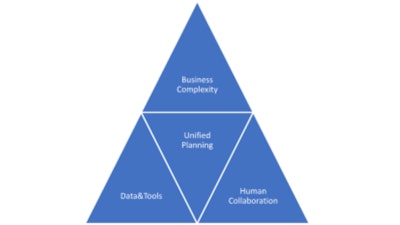
Sales planning is not what it used to be. Data assets are more available than ever to the sales planning organization. Identifying complex customer behavior with analytics tools can take the headache out of the process of setting goals and quotas. Simplifying the process for sales managers is the ultimate goal, which enables them to focus on sales and execution of the plan, not the development of the plan itself. It is easy to understand how sales staff can get lost in the mire of data. Motivation plummets and sales performance suffers. Alignment of CRM data and the financial planning process and systems empowers operational effectiveness.
Spreadsheets and other isolated solutions quickly reach their limits while the lack of automation and limited data availability disrupt the planning flow. Strategic sales planning, on the other hand, forms the foundation for operational and sales planning and provides a framework for evaluating and controlling concrete measures. We call this top-down and bottom-up planning, creating transparency based on unified data. Simplifying the creation of multidimensional views of the sales organization and strategy with accurate planning is the goal.

Strategic sales planning (top-down) is considered the engine of the sales organization, which ensures that all sales activities are aligned with corporate goals. Alignment with the Finance function and IT create a synergy to execution. Thoughtful top-down planning lays the foundation for a successful go-to-market strategy establishing the cornerstone for executing the organization’s long-term strategy and ensuring sustainable growth.
In the day-to-day business of operational planning, where revenues, sales volumes, cost of goods sold, and other measurable values determine the path. Alignment of strategy to data, process and people creates a culture of sales excellence within which a strategic framework can work. Strategic planning acts as a missing piece of the puzzle, seamlessly aligning with a company's vision, mission and values to provide a clear roadmap to success.
Unified planning increases efficiency and effectiveness across all areas of the company by supporting employees in planning with a software-based solution. It accelerates and simplifies processes while clearly revealing hidden potential. Simply put, leverage technology and data to enable greater focus on growth and execution.
The Case of Zimmer
Zimmer is a worldwide leader in musculoskeletal health care, developing innovative joint replacement systems. With a global workforce of 9,000 employees and billions of dollars in annually generated sales, the company sells over 130,000 orthopedic products through subsidiaries in 25 countries and partners in over 100 countries. Zimmer’s demanding sales model focuses on close cooperation with medical clinics and other clients. In order to drive sales, its account managers constantly require access to accurate information. Zimmer was using Salesforce for its CRM needs, a system that lacked the comprehensive reporting capabilities required to track and understand client spend and profit. Spreadsheet use skyrocketed, with chaotic data leading to lower quality through increased manual input. Business users were continually frustrated by multiple data sources and a lack of transparency. The company needed an alternative to Excel and decided to look for a solution that could seamlessly connect with Salesforce, as well as SAP, and other data sources. This move eliminated error-prone manual activity for its 2,500 users and boosted the efficacy of their sales management system astronomically.
Improved sales insights allow accurate planning and profitable forecasts to be derived. Decision-makers have access to up-to-date, secure data and information. This enables optimal control of the customer and product mix, capacity planning and sales cycles. For the sales team, transparent data provides motivation and drive.
The Final Word
In summary, the benefits of a unified, collaborative planning are clear. It provides more focus through driver-based sales planning, integration through a uniform  Baldwin
Baldwin
Eric Baldwin brings 20 years of professional experience in solution advisory, customer success and business process optimization to his role as Vice President of Customer Success for Jedox, Inc. His background in database design and software development have guided his focus on end-to-end solution delivery for clients in a variety of industries including telecommunications, consumer packaged goods, transportation and logistics, and manufacturing.






















